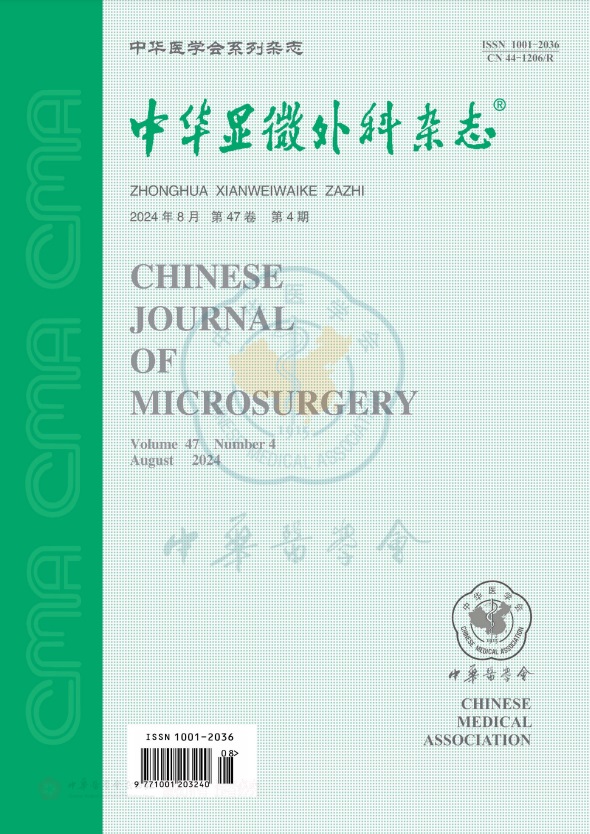Repair of medial plantar wound with posterior tibial artery perforator combined with saphenous nerve nutrient vessel fascial flap
引用次数: 0
Abstract
Objective To investigate the surgical technique and its clinical efficacy of the flaps with double blood supply through posterior tibial artery perforators and saphenous nerve nutrient vessels for the secondary stage repair of medial plantar defects. Methods Thirteen patients with medial plantar tissue defects, who were repaired by posterior tibial artery perforator flaps combined with saphenous nerve nutrient vascular fascia flaps from January, 2016 to December, 2018, were studied. The patients were 9 males and 4 females, aged 23-69 (mean age 36.9) years. All defects were near the tarsometatarsal joints in the medial planta, and the soft tissue defects were 4.5 cm× 5.0 cm-8.0 cm×14.0 cm in size. The donor sites were directly sutured or repaired with free graft of ipsilateral thigh full-thickness skin. All patients in this study were followed-up for 6-12 months to observe the function of affected limbs and the recovery of flap donor and recipient sites through outpatient visits and telephone reviews. Results All the 13 flaps survived successfully. One flap developed a small area of necrosis at the distal end, which was healed after partial stitch removal, decompression and dressing change. Another flap had shown purple bruises and tension blisters, surgical exploration was then performed to remove local hematoma and the flap survived after pedicle stitch removal and decompression. One flap received flap thinning and shaping at 8 months after surgery. All flaps showed normal in color, temperature, capillary reaction, soft in texture and without swollen appearance. The affected feet were not apparently restricted when walking, and the functions had satisfactory recovery. Conclusion Posterior tibial artery perforator flap carrying saphenous nerve and great saphenous vein is able to achieve higher and reliable flap survival and better blood supply. Anastomosis of the saphenous nerve carried by flap with cutaneous nerve of the recipient site helps to reconstruct the protective sensation of the flap, which is an effective approach in clinically repairing of the medial plantar defects. Key words: Posterior tibial artery perforator flap; Saphenous nerve nutrient vascular fascial flap; Medial plantar; Soft tissue defect; Repair胫后动脉穿支联合隐神经营养血管筋膜瓣修复足底内侧创面
目的探讨经胫后动脉穿支及隐神经营养血管双血供皮瓣二期修复足底内侧缺损的手术方法及临床疗效。方法对2016年1月~ 2018年12月采用胫后动脉穿支皮瓣联合隐神经营养血管筋膜皮瓣修复足底内侧组织缺损13例患者的临床资料进行分析。患者男9例,女4例,年龄23 ~ 69岁,平均年龄36.9岁。所有缺损均位于跖内侧跗跖关节附近,软组织缺损大小为4.5 cm× 5.0 cm ~ 8.0 cm×14.0 cm。供区直接缝合或用同侧大腿全层皮肤游离移植修复。本研究对所有患者进行随访6-12个月,通过门诊和电话复查观察患肢功能及皮瓣供、受体部位的恢复情况。结果13个皮瓣全部成活。其中一个皮瓣在远端出现小面积坏死,经部分拆针、减压和换药后愈合。另一侧皮瓣出现紫色瘀伤及张力性水泡,手术探查切除局部血肿,皮瓣经蒂针拆除减压后存活。其中1个皮瓣于术后8个月行皮瓣减薄整形。皮瓣颜色、温度、毛细反应正常,质地柔软,无肿胀现象。患足行走无明显限制,功能恢复良好。结论携带隐神经和大隐静脉的胫后动脉穿支皮瓣可获得较高可靠的皮瓣成活率和较好的血供。皮瓣携带的隐神经与受区皮神经吻合有助于重建皮瓣的保护感觉,是临床上修复足底内侧缺损的有效途径。关键词:胫骨后动脉穿支皮瓣;隐神经营养血管筋膜瓣;足底内侧;软组织缺损;修复
本文章由计算机程序翻译,如有差异,请以英文原文为准。
求助全文
约1分钟内获得全文
求助全文
来源期刊
CiteScore
0.50
自引率
0.00%
发文量
6448
期刊介绍:
Chinese Journal of Microsurgery was established in 1978, the predecessor of which is Microsurgery. Chinese Journal of Microsurgery is now indexed by WPRIM, CNKI, Wanfang Data, CSCD, etc. The impact factor of the journal is 1.731 in 2017, ranking the third among all journal of comprehensive surgery.
The journal covers clinical and basic studies in field of microsurgery. Articles with clinical interest and implications will be given preference.

 求助内容:
求助内容: 应助结果提醒方式:
应助结果提醒方式:


